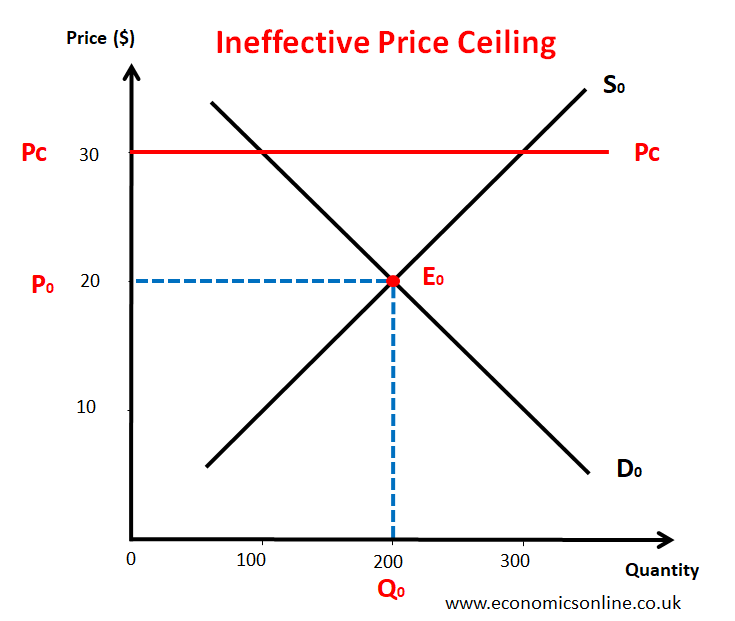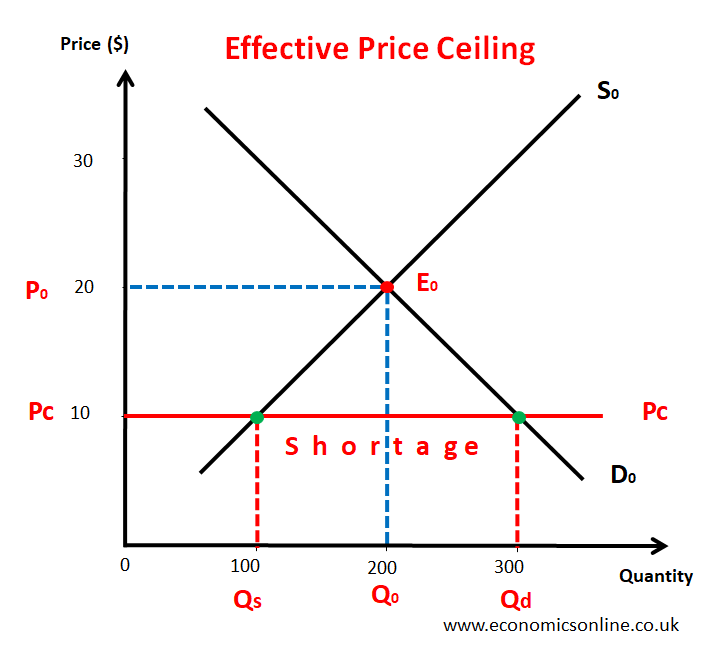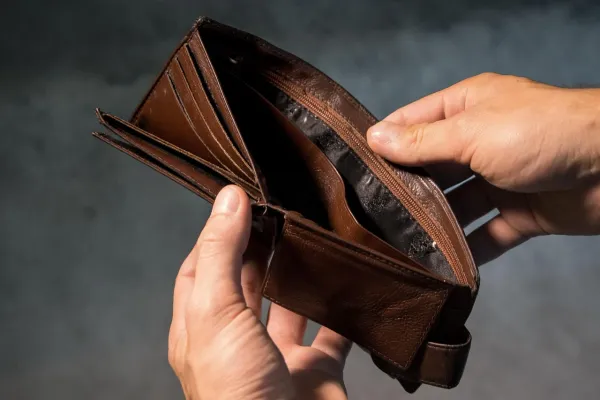
An image showing the prices of some vegetables.
Price Ceiling Demystified
What is a Price Ceiling?
A price ceiling refers to the maximum legal price that can be charged for a product. It is a price control law used by governments to make sure that the prices of certain goods and services do not rise above a certain level. It is also called the maximum price.
When the law of the price ceiling is in place, it becomes illegal to charge any price higher than the price ceiling. Hence, the market price of the product must not exceed the price ceiling.
Why is Price Ceiling Used?
In a free market, the price of a product is determined through the interaction of its demand and supply without government intervention. This price, at times, may be very high due to market imperfections like monopolies or oligopolies or due to higher demand and lower supply during off-seasons for the product. This higher price may not be affordable for some customers. Customers might also feel exploited if the product is a necessity. Hence, governments want to support those customers by ensuring that the price does not go beyond a certain level.
Examples of Price Ceiling
Governments can use price ceiling for many products, including:
Rent Controls
Rent controls in certain types of housing, which limit the monthly rent charged for apartments or rental units by landlords, are examples of price ceiling. This will reduce the rent of a typical apartment and condos for potential renters but may create the shortage of rental housing leading to the availability of fewer apartments.
School Fee
Limits on the school fee charged from students is another example of a price ceiling.
Staple Food
A price ceiling is also imposed on staple food items such as bread, rice, and cooking oil.
Utilities
Governments also use price ceilings on the services provided by utilities, such as electricity, water, and gas.
Transport Fares
Governments can also use price cap for transport fares.
Prescription Drugs
Caps on the prices if prescription drugs and lab tests are also the examples if price ceiling.
Types of Price Ceiling
There are two types of price ceiling which are explained below.
Ineffective or Non-binding Price Ceiling
A price ceiling is considered ineffective if it is set above the market equilibrium price. This price ceiling is called ineffective or non-binding because it will not reduce the price of a product from its existing market equilibrium price. This is illustrated by the following diagram:

In the above diagram, the existing market equilibrium price is P0, which is $20. The government has set the price ceiling (Pc) at $30. This price ceiling of $30 is higher than the equilibrium price of $20. Hence, it is ineffective, and sellers will keep on charging the same $20 price for the product.
Effect on the Market
An ineffective price ceiling has no effect on the market, and the market will keep operating at its original equilibrium position.
Sellers are charging a price equal to $20. When a price ceiling is imposed by the government, the market price must not exceed the price ceiling. In this case, the market price of $20 is already below the price ceiling of $30. So sellers will keep charging the prevailing price, making this price ceiling ineffective as it has no effect on the market.
Effective or Binding Price Ceiling
A price ceiling is considered effective if it is set below the market equilibrium price. This Price ceiling is called an effective or binding price ceiling because it will reduce the price of a product from the existing market equilibrium price. This is illustrated by the following diagram:

In the above diagram, initial equilibrium level is E0 and the existing market equilibrium price is P0, which is $20. The government has set the price ceiling (Pc) at $10. This price ceiling of $10 is less than the equilibrium price of $20. Hence, it is effective, and sellers cannot charge the existing $20 price for the product. In fact, it is now illegal to charge any price higher than the price ceiling of $10.
Effect on the Market
An effective price ceiling will immediately reduce the price of the product, and the market cannot operate at its normal equilibrium position.
Sellers were charging a price equal to $20. When a price ceiling is imposed by the government, the market price must not exceed the price ceiling. In this case, the market price of $20 is higher than the price ceiling of $10, shown by the horizontal line. As any price above $10 will become illegal, sellers will be able to charge the maximum price of $10.
In the above figure, at the price ceiling (Pc) of $10, production or quantity supplied (Qs) of 100 units, is not sufficient to satisfy everyone who wishes to buy the product, i.e., the new quantity demanded (Qd) of 300 units. This is a market shortage or excess demand. Consequently, as the price cannot increase, the available quantity supplied of 100 units, has to be allocated on some other basis.
The most likely way is by means of waiting lines or queues. Customers have to wait in lines in order to get the product.
Rationing is another method of restricting demand. This means that each customer will get a limited quantity of the product.
Waiting lines and rationing can lead to the emergence of an informal, black, or underground market for the product, with consumers then having to pay a higher price well above the ceiling price. Such black markets inevitably arise when there are dissatisfied customers who have not been able to buy the goods they want because of a lack of supply.
Advantages of an Effective Price Ceiling
An effective price ceiling can generate many benefits, including:
Immediate Price Reduction
One of the primary benefits of price ceilings is the immediate reduction in price. This can alleviate financial burdens on vulnerable populations, ensuring access to necessities. The customers who will buy the products at a lower price will be happy because of the increased consumer surplus and hence their welfare.
Consumer Protection
Through an effective price ceiling, buyers are protected from being exploited by sellers who are charging high prices. Consumers also feel secure because they are protected from any sudden rise in the price of the product.
Lower Cost of Living
An effective price ceiling will keep the cost of living low by controlling the prices of products. This will also help in controlling inflation and will be a sigh of relief for the poor people in society in terms of their basic standard of living.
Disadvantages of an Effective Price Ceiling
While price ceilings aim to protect consumers, they can have the following drawbacks.
Market Shortage
An effective price ceiling will create a market shortage or excess demand as the market cannot operate at normal equilibrium due to the capped price. This means that the price mechanism and the market forces are not allocating the resources.
Reduced Quantity Supplied
Sellers of the product may reduce their supply or choose not to enter the market at all due to the price constraint.
Due to the price ceiling, sellers may find it unprofitable or less profitable to produce products at the capped price. This will reduce the quantity supplied of the product from the original quantity, which will not be sufficient to meet the existing demand for the product.
Waiting Lines or Queues
At the price ceiling, the quantity demanded of the product is greater than the quantity supplied. Due to excess demand, consumers may have to wait in long lines to purchase the products. This inconvenience can create frustration and dissatisfaction among consumers.
Dissatisfied Customers
Despite the price ceiling, not all consumers may be able to purchase the product they need due to the limited quantity supplied. When waiting lines form, only some customers will be able to get the product, while the remaining customers will go home empty handed. Even in cases of rationing, customers will get a smaller quantity of the products. This can result in dissatisfaction among those who are unable to acquire the products.
Black Markets
Due to the price ceiling, there is a possibility of the emergence of underground, informal, or black markets because the price ceiling makes it difficult to obtain goods through legal channels. These black markets operate outside the control of the government and often involve higher prices, lower quality goods, and potential illegal activities.
Administration Cost
The government has to spend money on enforcing price ceilings. This might include the costs of monitoring the prices, conducting inspections, and taking legal action against violators.
How can Governments Overcome Market Shortage?
The government can solve the problem of market shortage by increasing the supply of the product in the market by producing that product or by offering subsidies to sellers to encourage production of these products. Governments can also release previously stored stocks of the products.
Price Ceiling vs. Price Floor
While price ceiling is the legally fixed maximum price which can be charged for a product, theprice floor is the minimum price which canbe paid for a good or service. National minimum wage used in labor market is an example of a price floor. Price floor is also used for the farmers of wheat, rice or other agricultural commodities to protect their farm incomes. While price ceiling is used to protect consumers, the price floor is used to support producers by increasing their producer surplus through an increase in the price of the product.
Alternatives to the Price Ceiling
While a price ceiling may appear to be a straightforward solution to control the price of some products, it has several drawbacks. The government can explore and use some alternatives to the price ceiling in order to decrease the price of products. These alternatives may include direct subsidies to producers and promoting competition in the market.
Conclusion
Price ceiling is a legal maximum price and is a handy tool used by governments to control prices and protect consumers. While a price ceiling may initially seem beneficial, its negative effects can be many, including market shortage, waiting lines, and the emergence of black markets. Governments must carefully weigh the benefits of price ceiling against its drawbacks when considering its implementation. One possibility is to use a price ceiling for a short period of time. The government can also explore alternative measures to reduce the price of products.


